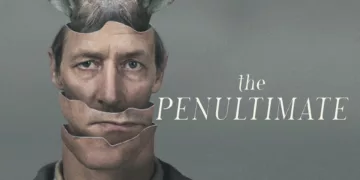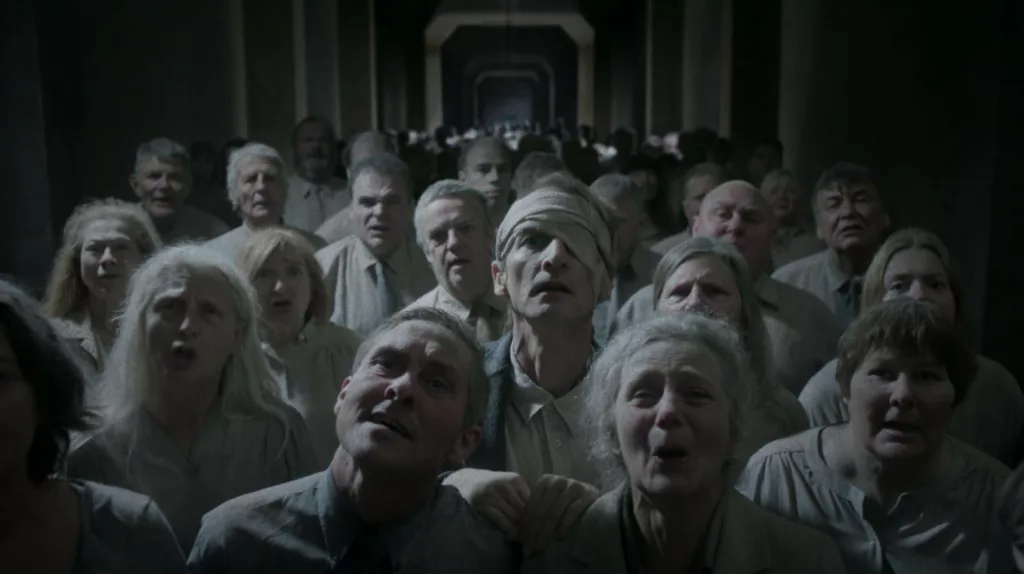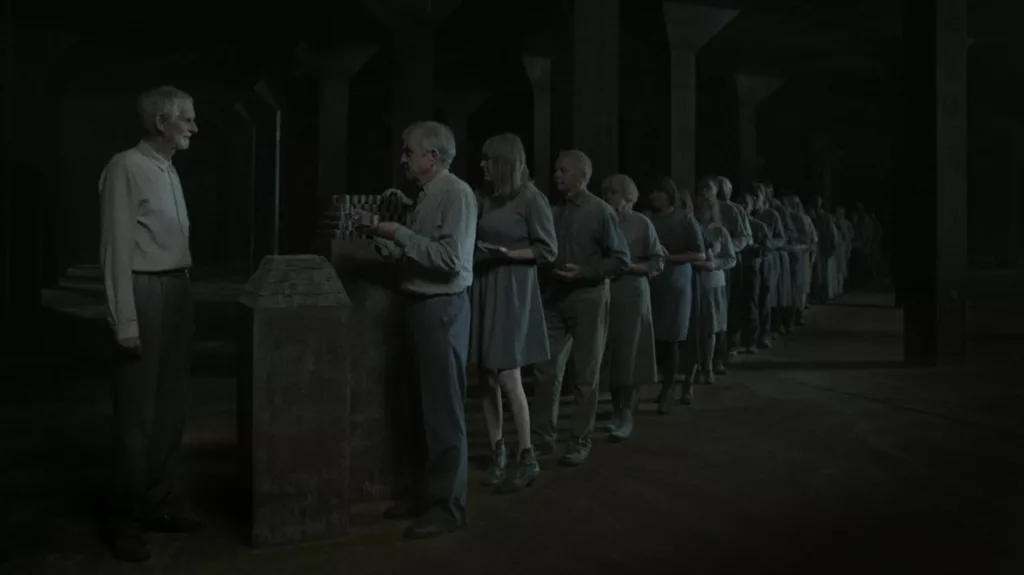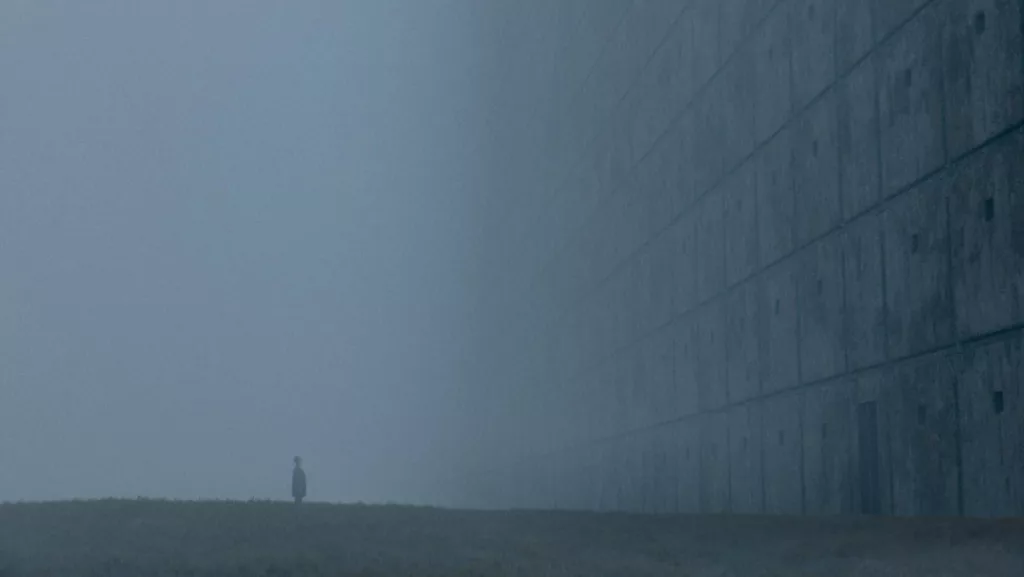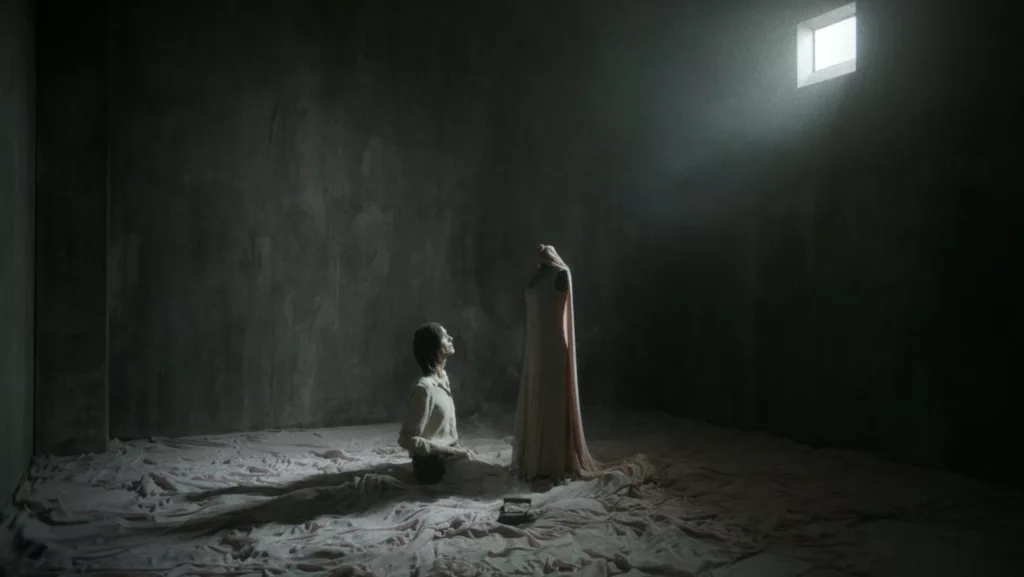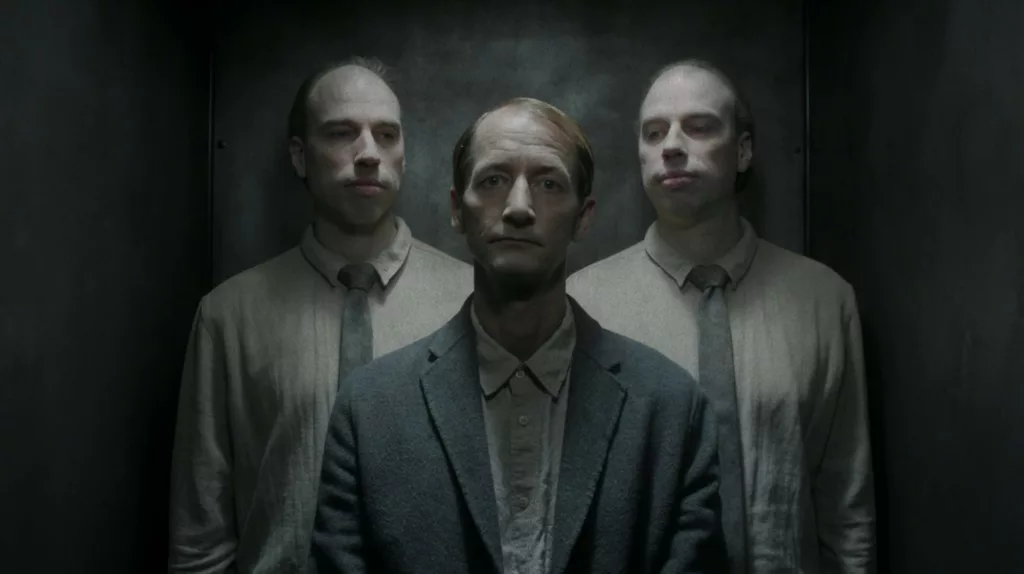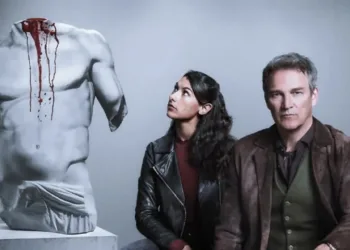Jonas Kærup Hjort’s directorial debut, The Penultimate, tells a deeply philosophical story through sparse but resonant imagery and dialogue. The film follows an unnamed water inspector who enters a cavernous concrete building to check meters but finds himself trapped inside. As days and months pass in this strange place, he experiences increasingly surreal encounters with the other enigmatic residents.
Shot in austere black-and-white and square 4:3 aspect ratio, the film embraces minimalism to focus viewer attention on its abstract exploration of human existence and suffering. Very little is explicitly explained as the inspector engages in oblique conversations and endures ominous ordeals. Meaning is not spelled out but left open to interpretation.
Released in 2020, the film had its world premiere at the 24th Tallinn Black Nights Film Festival before screening at other international events. Hjort eschews traditional narrative techniques to craft a contemplative and unsettling story that challenges audiences in the best way. While not an easy or straightforward watch, those drawn to thought-provoking arthouse cinema will find much to ponder in this dense and imaginative work.
An Enigmatic Journey
The Penultimate tells a surreal tale that is equal parts mystifying and thought-provoking. A water inspector arrives at a sprawling concrete building to check meters but finds himself trapped inside an endless maze of hallways and rooms. As days turn to months, he encounters an assortment of peculiar inhabitants in his desperate attempts to find a way out.
Chief among these is The Tormented, a woman consumed by volatile emotions who lashes out violently at times. The Inspector also meets The Bride, a kindhearted soul hoping he can provide the companionship and family she craves. A mute boy poses profound questions about human nature and existence through sign language. The enigmatic caretaker, said to hold the key to exiting this place, becomes an almost mythical figure sought by all.
The film embraces ambiguity as the reason for the inspector’s imprisonment and the building’s strange inner workings are left ambiguous. Director Hjort invites interpretation through a style not unlike Kafka—the protagonist is entrapped in a surreal, nightmarish world where the usual rules seem suspended. Symbolic meanings abound in even minor details like character names that signify roles over identities.
The concrete structure itself becomes a metaphor for confinement, whether physical, mental, or existential. Hjort heightens the unsettling atmosphere with austere black-and-white visuals and an unorthodox 4:3 aspect ratio that enhances the closed-in feeling. It’s a tale that stays with you, leaving space for pondering life’s deeper mysteries long after the end credits roll.
A Brutal World of Concrete and Confinement
The Penultimate transports viewers into a striking yet bleak world through its spare visual style and imposing concrete setting. Shot entirely within the confines of a massive brutalist building in stark black and white, director Jonas Hjort creates an atmosphere of inescapable entrapment and unease.
We feel the immense scale of this structure from the very first shots, but its spartan gray interiors are austere and mazelike. Identical bare rooms are connected by a disorienting layout of narrow hallways, with sparse furnishings providing few landmarks. Punctuated by tiny square windows high on the walls, it’s easy to get lost inside.
Hjort hangs on prolonged shots that soak in the emptiness and geometric lines of this place. His static camera puts us right alongside the Water Inspector as he futilely searches hundreds of identical doors for a way out. The winding search takes on nightmarish qualities that deepen our feelings of being trapped.
At just 4:3, the tight square aspect ratio further enhances the confined setting, squeezing the frame and keeping characters hemmed in. It makes even the lift feel claustrophobic, while doorframes loom ominously over the inspector. The box-like shape composes every scene like a prison cell.
This is a setting designed to drain hope and spark madness through its relentless gray scale and repetition. Yet it also serves to observe how people cope in isolation. Some residents find ways to personalize spare rooms or carve out private social circles. But for the Inspector, it remains a faceless labyrinth, tormenting his drive to escape.
The building acts as both a physical and psychological barrier, representing internal obstacles preventing characters from fulfilling desires or pursuing truths about their realities and themselves. Its brutal architecture is a perfect vessel for exploring existential themes of alienation, suffering, and the limits of human endurance.
Without score or embellishment, the minimalist environment and cinematography become keys to thrusting viewers into this bleak thought experiment. It’s an audacious setting that enhances our unsettled experience with the characters.
Suffering and the Search for Meaning
The Penultimate isn’t just a film—it’s a thoughtful examination of what it means to be human. At its core, it grapples with some of life’s biggest questions through its portrayal of suffering and our universal human experiences.
One of the most poignant scenes shows a boy in sign language asking the Water Inspector, “Do you think suffering is a necessary part of the human condition?”. This question hangs over the entire film as countless characters wrestle with their own afflictions. Whether emotional, physical, or existential, each deals with suffering in its own way.
The inspector tries desperately to escape through the building’s endless doors, only to be beaten down further. A teacher contends with trauma that leaves him suicidal. The tortured lashes out with violence born from her deep loneliness. Each character endures immense pain, both inflicted and self-imposed.
But suffering isn’t just shown—it’s dissected and analyzed. Why do we endure hardship? What drives our desires for things like love, meaning, or answers? In questioning if humanity is “going in a good direction,” the film raises profound interrogations about life’s difficulties and our constant search for purpose.
It also critiques the false utopias we sometimes construct, like the building itself, which promises order and efficiency but only breeds further isolation. Within its gray walls, residents obsess not over personal growth but over petty goals of status and pleasure that leave them empty.
Ultimately, The Penultimate suggests that suffering is intrinsic to human nature. We all wrestle with despair, trapped within systems and cyclical patterns not of our making. But what’s left when stripped of distraction? And can we find connections with each other in our shared fragility? The answers remain open, for suffering defies easy solutions.
Through sparse but deeply felt portrayals of psychological and emotional struggle, the film immerses viewers in questioning life’s hardest realities. It’s a thoughtful piece of art that doesn’t pretentiously lecture but humbly reflects how we grapple with the inevitable pains of living in this world.
The Power of a Film’s Soundtrack
Striking visuals aren’t the only draw of The Penultimate; it’s the sound design that helps make it such an enveloping experience. Sound plays a pivotal role in pulling audiences deeper into this film’s contemplative world.
Rather than simply accompanying the images on screen, the movie’s soundscape expands the narrative space. It provides a richness complementing the Spartan surroundings. An intricate balance of effects and silence creates an atmospheric backdrop that feels profoundly immersive.
Every ambient noise and silence has intention driving the story. Whether it’s the echo of footsteps in sparse rooms or the howling wind buffeting the giant structure’s walls, sounds flesh out the setting into something almost tactile. Dialogue, too, feels a bit more visceral and raw through the strategic use of acoustics.
It’s a mastery of sound to enhance emotions. Lonely despair rings clearer in an extended moment of nothing but a lone character’s cries. Tension simmers heavier through the selective inclusion of creaks and groans. Conflict hits with visceral impact alongside chaotic percussion in violent scenes.
All this elevates the viewing experience beyond passive watching. Drawn into careful soundscapes, audiences may feel like voyeurs in this muted world. The film shows how much a non-visual element can immerse and provoke thoughtful observation of both characters and themes.
It’s easy to grasp why some felt this tale may have resonated even more on a big screen. With theater-quality sound unfolding around, it could truly transport viewers straight into the heart of The Penultimate’s contemplative atmospherics. The soundtrack deserves praise for how artfully it contributes to the film’s effect.
Making Sense of The Penultimate
There’s much going on beneath the surface of The Penultimate. While its plot presents a bizarre tale of one man trapped in a strange building, the film feels designed to represent something more. Let’s consider what Hjort may be conveying through his abstract symbolism and surreal situations.
The imposing structure could be seen as a metaphor for imprisonment, both physical and mental. Is the Water Inspector trapped not just within unyielding walls but also within beliefs that restrain him? Other characters seem shackled by inner turmoil, which is only more distressing amid the isolation. Their desire for human connection hints at how we all crave escape from loneliness, even if we erect its cages ourselves through things like fear and stubbornness.
Recurring themes of control, identity, and reality spark questions too. We glimpse a system that strives to shape its dwellers, robbing them of individuality. Yet authentic selves persist, showing the human spirit’s strength. Scenes implying a harsh regime of rules and punishment likewise comment on societies where bureaucracy and uniformity defeat soulfulness. And is there meaning beyond this building, or have we walled out all higher truth?
Throughout, the boy’s queries to the Inspector on suffering and humanity’s course add philosophical layers. Are such tribulations life’s givens we must accept? Or can we steer a kinder path? His non-answers are thought-provoking too, as facing profound questions often leaves us mute.
By the film’s end, with liberation in a natural realm of new potentialities, does Hjort offer hopeful wisdom? Perhaps he suggests that however tightly circumstances squeeze us, renewal is there if we unshackle ourselves from needless constraints and walk toward the light once more. In this dazzlingly oblique opus, every moment rewards those willing to read deeply between the enigmatic lines.
A Thought-Provoking Experience That Lingers
With The Penultimate, Jonas Kærup Hjort has crafted a slow-burn film that lingers in the mind long after viewing. Working within stark, enclosed settings, he leads us on an introspective journey to uncover deeper questions about the human condition.
Hjort shows skill in using minimalism to draw out raw emotions and ponderous dialogue. The austere visuals and unrevealing characters become blank slates on which we project our own thoughts. At times surreal and disturbing, it’s a voyage that stimulates analysis and debate.
We watch the Water Inspector confront isolation and futility while grappling with bleak existential queries from a mute child. Though the plot progresses little, much is uncovered about dignity, desperation, and why we build inner prisons. The cryptic narrative and obscure residents spark interpretation.
Admittedly, this demands patience and an openness to unconventional storytelling. But for those seeking thoughtful films that challenge assumptions, The Penultimate delivers a rich experience that provokes reflection well after exiting its ominous building.
Through his direction, Hjort breathes life into the construction of an otherworldly microcosm that mirrors humanity’s collective journey. While not for all tastes, it shows how even sparse components can plunge viewers into profound realms when guided by a visionary artist. For an unforgettable thought-starter, give this one a chance. It may linger with you, too.
The Review
The Penultimate
The Penultimate is a stylish and thought-provoking piece of cinema that will linger with viewers seeking more from films than mere entertainment. Through minimalist visuals and abstract storytelling, Hjort crafts an immersive world that holds a reflective mirror up to the human experience. While not an easy watch, it challenges audiences in a way that more mainstream films do not. For those with the patience to immerse themselves in its provocative and surreal atmosphere, The Penultimate offers a rewarding experience that prompts deeper discussion and introspection.
PROS
- Thought-provoking themes and symbolism about human nature
- Striking visual style and production design
- Strong performances from the lead actors
- Provokes analysis and debate after viewing
- Director's unique vision and crafting of a surreal world
CONS
- A slow and minimalist pace won't appeal to all viewers
- The cryptic plot and characters may frustrate some
- Demands patience and openness to abstract storytelling
- Could use more character development
- Leaves many elements open to interpretation
